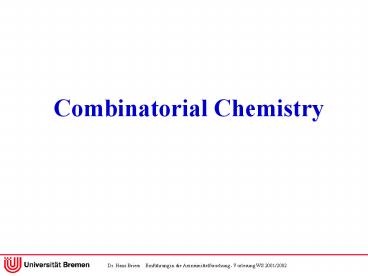Combinatorial Chemistry - PowerPoint PPT Presentation
1 / 47
Title:
Combinatorial Chemistry
Description:
Dr. Hans Briem Einf hrung in die Arzneimittelforschung - Vorlesung WS 2001/2002 ... septum. polypropylene reactor vessels. polymer beads. filter. valve ... – PowerPoint PPT presentation
Number of Views:7447
Avg rating:3.0/5.0
Title: Combinatorial Chemistry
1
- Combinatorial Chemistry
2
(No Transcript)
3
The Lead Discovery Process
4
- Basic characteristics of Combichem (I)
- Combinatorial Chemistry prepares
- a large number of different compounds
- simultaneously
- under identical reaction
- in a systematic manner
5
- Conventional Synthesis
one educt (A) reacts with one educt (B) to yield
one product AB
6
- Combinatorial Synthesis
different building blocks of type A react
combinatorially with different building blocks
of type B to yield a combinatorial library
7
- Combinatorial Synthesis
A1B1 A1B2 A1B3
A1 A2 A3
B1 B2 B3
A2B1 A2B2 A2B3
A3B1 A3B2 A3B3
8
- Why Combinatorial Chemistry?
- large numbers of compounds promise to increase
the chance of finding hits/leads - "feed the hungry beast" of HTS
- systematic variations increase the chance to find
Structure-Activity Relationships (SAR) - hits can be followed up more rapidly
9
- Basic characteristics of Combichem (II)
- Combinatorial Libraries can be structurally
related by - a central core ("scaffold")
- a common backbone
10
- Scaffold-based libraries
- (Example benzodiazepines)
11
- Scaffold-based libraries
- (Example benzodiazepines)
12
Backbone-based libraries (Example peptides)
13
- Basic characteristics of Combichem (III)
- Combinatorial Chemistry runs either
- on solid support ("solid phase chemistry")
- in solution ("solution phase chemistry")
14
- Basic characteristics of Combichem (IV)
- Combinatorial Chemistry prepares either
- mixtures ("combinatorial libraries") or
- single compounds ("arrays")
15
- Mixtures vs. Arrays
- The Split-Pool Synthesis Method to produce
mixtures
16
The Split-Pool Synthesis Strategy
17
Array-based Synthesis Strategy
18
The Combinatorial Explosion
The Number of peptides increases exponentially
with the number of combinations
19
- The Split-Pool Synthesis Strategy
20
- One bead - one substance concept
- Each bead contains only one sort of product
(50-200 pmol concentration) - Product can be screened either on bead or after
cleavage from bead - Single beads can be spotted in microtiter plates
or immobilized and screened individually
21
- How can we find the active component(s) of the
library?
- Deconvolution (iterative or parallel)
- Microsequencing
- Tag-based encoding methods
22
Iterative Deconvolution
23
Parallel Deconvolution (Positional Scanning)
24
Microsequencing of peptides by Edman degradation
25
Tag-based encoding methods
Encoding principle
- each individual bead contains an encoding tag
- each tag uniquely encodes the building blocks
on the bead
Encoding tags in use
- DNA (analysis by PCR)
- Peptides (analysis by Edman degradation)
- Haloaromatic groups (suitable for "binary code")
- Secondary amides (suitable for "binary code")
- Radiofrequency transponders
26
Chemical encoding tags for solid-phase synthesis
27
Example of chemical "binary code" (taken from
Ohlmeyer et al. PNAS 90, 1993, 10922-10926)
Binary translation table Ser (S) 001 Ile
(I) 010 Lys (K) 011 Leu (L) 100 Gln (Q)
101 Glu (E) 110 Asp (D) 111
Sequence E Q K L I
S Binary Code 110 101 011 100 010 001
Tags T18 ... T1
"1" in binary code means "tag is present" "0" in
binary code means "tag is absent"
Peptide Sequence E Q K L I S Tag
Sequence T18 T17 T15 T13 T11 T10 T9 T5 T1
28
Tag analysis by electron capture GC (taken from
Ohlmeyer et al. PNAS 90, 1993, 10922-10926)
29
Encoding by Radiofrequency chips
- Synthesis by Split-and-Pool principle
- Polymer beads are located in a microreactor
vessel - Each microreactor vessel contains one
semi-conductor chip - Unique radiofrequency signals can be recorded
and detected
30
IRORI Kan - , Chiron Pin Technology
31
Biopolymers used in Combinatorial Chemistry
vinyl. Sulfonyl- peptides
Peptides
vinyl. Peptides
Peptoids
Oligo-carbamates
Oligosulfones
Oligo- ureas
Oligosulfoxides
32
- Non-polymeric combinatorial libraries
- Since biopolymers are often not "drug-like",
efforts have been made to synthesize single,
"drug-like" molecules combinatorially - Solid-phase or solution phase synthesis is
possible for a wide variety of organic reactions - Automation support synthesis
33
- Some examples...
34
(No Transcript)
35
(No Transcript)
36
- Automation
37
Solid phase-combinatorial chemistry to prepare
single compounds
38
Schematic representation of a reaction block for
solid-phase synthesis
39
Solution-phase combinatorial chemistry
40
Automation I
Synthesis robot for solid-phase chemistry A
Reactor block B/C Reagent supplies D Robot
arm with pipetting needles
41
Automation II
Reactor block for solid or solution phase
synthesis A Reaction vessels B Teflon
device C Pipetting needles
42
Automation III
...more reaction blocks
43
Automation IV
"Igel" multipipetting synthesizer for solution
phase chemistry
44
Automation V
Fully automated synthesis robot from Accelab
GmbH
45
- Combinatorial Chemistry is more than just large
numbers! - systematic variation of substituents on a
common template - is a key feature of combinatorial chemistry
46
- The systematic variation of substituents
- is ideally suited to explore SAR patterns of
hits found - in combichem libraries
Variations in R1
Variations in R2
47
Combinatorial libraries































